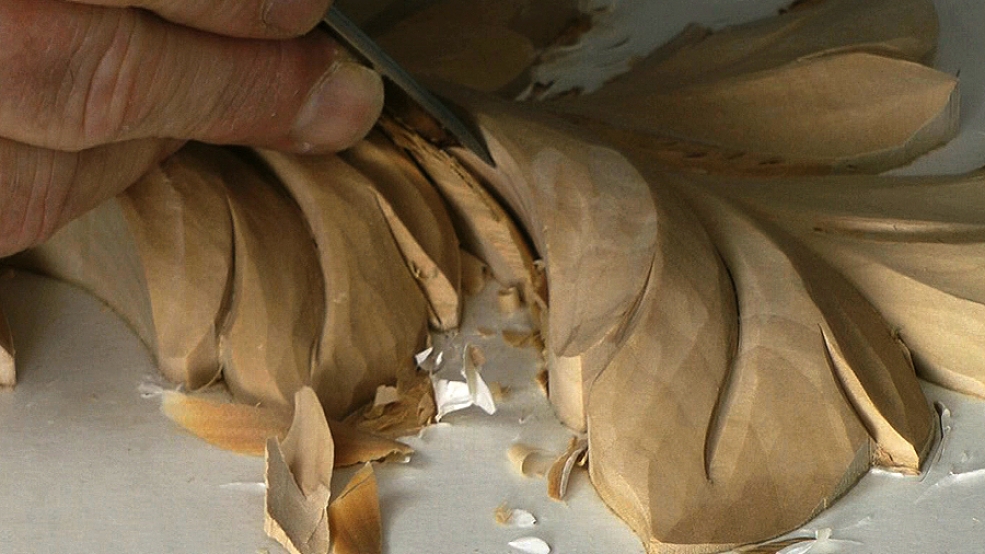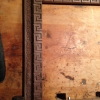You've just watched 8 Baroque part 5
More videos from


Baroque leaves are quite heavily undercut, which gives them a lot of deep shadows and thus drama.
After we've refined the leaves and undercut, we need to remove the carving from the backing board.

| 22 October 2020 14:28
Imran - You can glue it and on, say a mantlepiece frieze or where it's likely to be knocked, it makes sense. It's tricky dealing with glue squeeze out in areas that are difficult to reach and there is also the possibility if differential movement between the leaf and the wood it's glued to.
With pinning, you use fine pins through unobtrusive junctions in the carving, dovetailing the pins into the backing board and punch them under the surface, filling later with your wax finish. This can be a very secure way of holding.
I tend to mix and match, pinning and with a few discrete touches of glue.
In every case the term for what you are doing is 'appliqué. The big advantage is that you haven't spent ages working a relief background; the background wood will be pristine and you can use a different one to the carving for contrast and interest.

| 21 October 2020 23:41
Hi Chris. How would one display an individual leaf ( or a small group of leaves) like this? Would you somehow tack these to a backing board (finished piece of wood)? Would you glue it on?

| 29 November 2016 18:22
Karen - The leaf is undercut all around at about the same angle.
If the leaf swoops down to the backing board, you only see a little of the undercutting; when the leaf arches away, you see (and need therefore to do) a lot more.

| 12 January 2016 09:34
I absolutely love this video! I think the cartouche is
my favorite but this is a very close second!

| 13 June 2015 10:02
Sauro Sarti| June 12,2015
What can i say.....wonderful!

| 25 August 2014 07:19
Pete - There are worse things to become obsessive about! The 20:20 rule is in the 'No Fear Sharpening' series. Remember to strop with the angle consistently LOW so you don't increase the cutting angle over time - it's easy to lift the handle as you drag the blade towards yourself. I agree: there's nothing quite like the feel and sound of that 'zippp'...

| 24 August 2014 15:47
Hi Chris Not too sure how many times I've watched this one but it's becoming obsessive! Brilliant and I love Carrie's superb close ups. With regard to the stropping, I seem to remember reading in one of your books, I think, that you tend to follow a twenty rule, twenty minutes carving, twenty strops. I've adopted this and find it great. However, as most of my work is in Oak I do tend to strop more often and give more strokes, but, the sheer pleasure of a super sharp tool gliding through the wood cannot be over emphasised and is worth every stroke.

| 30 March 2014 03:58
I agree the filming, highly detailed close ups, etc are magnificent and extremely helpful. I managed successfully carve this leaf from basswood and am extremely impressed.
On a similar note, I am a huge fan of acanthus leaves especially of the dramatic baroque style which can be found in a lot of different mediums in many fine art museums, art history books, et cetera. (As a matter of fact when at a museum I find myself drawn to the elaborate acanthus frames sometimes more than the priceless paintings which they hold). I would absolutely love more acanthus videos. Perhaps one with smaller acanthus leaves making up a picture frame, sconce, or scrolling bracket.
Thank you so much for sharing your skills, techniques and tricks and combining them with clear rationales. You are both an amazing carver and teacher.

| 01 October 2013 15:09
Tony - Excellent! Few of us can expect to get something like this right on a first go, so repeating and learning and improving is absolutely the best way to go. Then, you can start extending your skills, finding a leaf that's a little more challenging or joining designs together for example...

| 30 September 2013 14:06
Chris - just completed my first month on your site. Great Stuff! As I watched your videos on the acanthus leaves I found myself blowing on the computer screen trying to remove your wood chips. A little embarrassing when my wife asks why I'm blowing at the computer. I completed two acanthus leaves. the first one I wasn't totally happy with but not throw away. I decided to do the second but did it in a mirror image of the first. A challenge to keep my orientation proper while watching the videos and doing everything on the opposite side. Results were again not totally happy but improvement from the first.

| 19 April 2013 18:30
David - There's no hard and fast rule; it depends on how you use the tools, the hardness of wood etc, as to how often you strop. The best I can say is that you need to develop a sensitivity to the cutting edge so that as soon as you even THINK the edge is dull, strop. It's also a sort of discipline. It's always tempting to do that bit more after you get a niggle that the edge is losing it a bit, but resist! Strop. More frequently than you might expect.

| 19 April 2013 12:39
Hi Chris. These Acanthus Leaves have been very informative to watch and learn from. I am having some problems knowing when my tools may need stropping and sometimes think I may have left it too long.As a kind of rough guide, how many times or how often, would you have stropped your tools during the carving of these leaves?

| 14 September 2012 01:16
Have a look at Relief > 3 Simple Leaves > Oak Leaf... It's only the one leaf but you can of course add several together ...

| 13 September 2012 13:02
Hi Chris, Thank you for the wonderful Acanthus leaves, any chance of oak leaves?